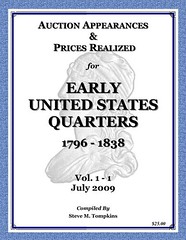
About UsThe Numismatic Bibliomania Society is a non-profit organization promoting numismatic literature. For more information please see our web site at coinbooks.org SubscriptionsThose wishing to become new E-Sylum subscribers (or wishing to Unsubscribe) can go to the following web page link MembershipThere is a membership application available on the web site Membership Application To join, print the application and return it with your check to the address printed on the application. Membership is only $15 to addresses in the U.S., $20 for First Class mail, and $25 elsewhere. For those without web access, write to: David M. Sundman, Secretary/TreasurerNumismatic Bibliomania
Society AsylumFor Asylum mailing address changes and other membership questions, contact David at this email address: dsundman@LittletonCoin.com SubmissionsTo submit items for publication in The E-Sylum, just Reply to this message, or write to the Editor at this address: whomren@coinlibrary.com
BUY THE BOOK BEFORE THE COINYou won't regret it! |
- WAYNE'S WORDS: THE E-SYLUM AUGUST 23, 2009
- NUMISMATIC LITERATURE DEALER RICHARD STOCKLEY RESTOCKS
- NEW BOOK: OVERSTRUCK GREEK COINS BY DAVID MACDONALD
- NEW BOOK: AUCTION APPEARANCES & PRICES REALIZED FOR EARLY U.S QUARTERS
- CARNEGIE INSTITUTE'S 1909 SAINT-GAUDENS MEMORIAL EXHIBITION
- CORRECTIONS AND SUGGESTIONS
- SWOGER SUES OVER NUMISMATIC RESEARCH USE
- ANSWER: 1851 DATED ONE DOLLAR ITEM IS A FANTASY PIECE
- QUERY: FRENCH FIVE FRANCS OF NAPOLEON
- QUERY: RECORDS OF MINNEAPOLIS MEDAL MAKER WENDELL'S SOUGHT
- VOCABULARY QUIZ QUESTION: BICENQUINQUAGENARY
- JOE LASSER ON DUTCH LION DOLLARS IN COLONIAL AMERICA
- QUERY: HOW LATE WERE SHILLINGS AND PENCE USED IN THE U.S.?
- QUERY: GUTTAG'S RARE COINS OF THE UNITED STATES
- QUERY: ENGRAVED MORGAN SILVER DOLLAR INFORMATION SOUGHT
- DICK JOHNSON SAYS: PLEASE DO NOT SLAB ART MEDALS
- READER THOUGHTS ON ANA CONVENTION SITE SELECTION
- BRAD KAROLEFF ON THE LOS ANGELES ANA CONVENTION
- MYSTERIOUS LEDGER SIX NINE FOUR: MONEY TO BURN
- ARTICLE FEATURES NUMISMATIC AUTHOR FRED HOLABIRD
- NEWTON AND THE COUNTERFEITER AUTHOR ON MODERN COUNTERFEITING
- HOWARD BERLIN VISITS THE MUSEUM OF THE NATIONAL BANK OF BELGIUM
- ROBOTS MAKING COINS AT THE ROYAL AUSTRALIAN MINT
- TOKENS SPREAD MESSAGE ABOUT DOMESTIC ABUSE
- UKRAINIAN ARRESTED FOR SMUGGLING AN ANCIENT COIN FROM RUSSIA
- 'HYPNOTIC' BANK ROBBERS ARRESTED
- FEATURED WEB VIDEO: THE FUTURE OF PAPER
WAYNE'S WORDS: THE E-SYLUM AUGUST 23, 2009

Among our recent subscribers are Philippe Schiesser, Bernard Dulucq, Georges Sion, Erwan Cuinet, Patrice Deheul, Philippe Lhuerre, Robert Salesse, and Philippe de Henaut.
Welcome aboard! We now have 1,253 subscribers. Thanks again to Michel Prieur for publicizing The E-Sylum - several of our new readers are from France.
This week's issue includes an announcement of new titles on ancient Greek coinage and U.S. Bust Quarters, plus a review of an Augustus Saint-Gaudens exhibition catalog.
Also featured this week are several queries from numismatic researchers and curious readers, covering topics as diverse as Lion Dollars, engraved Morgan dollars, the French five francs of Napoleon and the word "bicenquinquagenary".
To learn about the mysterious ledger 694, the Museum of the National Bank of Belgium, the hypnotic bank robbers and the coin-making robot, read on. Have a great week, everyone!
Wayne Homren
Numismatic Bibliomania Society
NUMISMATIC LITERATURE DEALER RICHARD STOCKLEY RESTOCKS
Numismatic Literature dealer Richard Stockley of Canada writes:
Richard Stockley
222 Ste. Anne
Ste. Anne de Bellevue, QC
Canada H9X 1N7
514-366-1704
rstockley@videotron.ca
http://www.abebooks.com/bookseller/stockleysbooks
From what I've seen in Richard's initial email price lists, the collection includes a great number of standard works on world coins, priced from just $5 to over $100. Drop him a note to get on his list.
NEW BOOK: OVERSTRUCK GREEK COINS BY DAVID MACDONALD
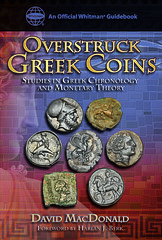 Whitman Publishing announces the release of Overstruck Greek Coins: Studies in Greek Chronology and Monetary Theory, by David MacDonald. The 288-page hardcover book will be available online, in bookstores, and from dealers nationwide in late September 2009, and can be preordered at www.WhitmanBooks.com.
Whitman Publishing announces the release of Overstruck Greek Coins: Studies in Greek Chronology and Monetary Theory, by David MacDonald. The 288-page hardcover book will be available online, in bookstores, and from dealers nationwide in late September 2009, and can be preordered at www.WhitmanBooks.com.
Overstruck Greek Coins is intended for serious collectors of ancient coins, but it is intriguing enough to appeal to general collectors and historians. It is the first book-length study to explain how Greek coins were overstruck, when they were overstruck, and why they were overstruck. Its revelations offer new understanding to students of ancient history.
"The sophistication of ancient cultures in monetary terms was revealed to me by this remarkable volume," said Harlan J. Berk, author of 100 Greatest Ancient Coins, who wrote the book’s foreword.
Overstruck coins are those that have been "recoined" by striking them with new and different dies, without first having the original design completely removed. In ancient times, this was done for various reasons: to certify the coins’ quality; to encourage their circulation in a faraway land; to restrict their export and keep them in local economies; to validate them for mercenary soldiers’ pay; to raise revenue; to avoid mandated recoining fees; or to make a political or patriotic statement.
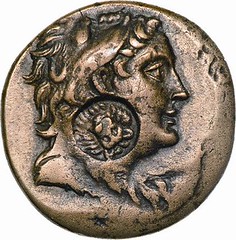 "Overstrikes have been recognized since the early days of numismatics, but the attention paid to them was, for a long time, sporadic and uneven," writes award-winning author David MacDonald. "The study of overstrikes has now become a standard part of numismatic methodology."
"Overstrikes have been recognized since the early days of numismatics, but the attention paid to them was, for a long time, sporadic and uneven," writes award-winning author David MacDonald. "The study of overstrikes has now become a standard part of numismatic methodology."
MacDonald’s engaging study includes more than 300 high-resolution photographs and line drawings showing overstruck coins and their undertypes; an appendix on previously published Mesambrian overstrikes; a gallery of actual sizes; detailed notes; and an extensive bibliography of pertinent books and auction catalogs. The author explores the regions of Gaul and Italy, Sicily, Bosporus, Macedonia, Thrace, Greece, Anatolia, Syria, Judaea, North Africa, and Indo-Greece, along with a study of several enigmatic pieces.
Overstruck Greek Coins: Studies in Greek Chronology and Monetary Theory
By David MacDonald
Foreword by Harlan J. Berk
288 pages ∙ Full color ∙ 6 x 9 inches ∙ Hardcover ∙ Retail $39.95 U.S.
Whitman Publishing focuses on popular titles, and a work with an academic-sounding subtitle (Studies in Greek Chronology and Monetary Theory) is unusual for them. But hooray! I hope this portends a wider range of titles in the company's high quality, affordably-priced line. -Editor
NEW BOOK: AUCTION APPEARANCES & PRICES REALIZED FOR EARLY U.S QUARTERS
Laid out in a similar format as the AMBPR for Bust Halves by Stephen Herrman, this AAPR lists over 5200 Bust Quarters from 1796 - 1838 by die marriage and in all grades, for as much as the last 15 years, that have appeared at auction, and their prices realized.
Auction House, Lot #, Date of the sale, Grade, TPG service, Slab certification #, and the price realized will be included as well as comments delineating problems mentioned and previous auction appearances.
The current plan is to produce an annual update unless demand dictates a need for a Bi-annual issue.
Please send payment to:
Steve Tompkins
P.O. Box 1946
Sequim, WA 98382
Or feel free to e-mail with any questions: smt115@aol.com
Steve adds:
While working on my Bust Quarter book (published in 2008), I attempted to compile a condition census for all of the Bust Quarter die marriages. I spent many hours pouring through auction catalogs and through online auction archives from the major auction houses. What I found truly amazed me. I knew that Bust Quarters were much rarer than many of their other bust series brethren, but not only were they rare overall, they were conditionally rare as well. In fact, many times I found that the same coin would appear multiple times at multiple auction houses and even in different Third Party Graded (TPG) slabs, sometimes at different grade levels.
While going through everything, I kept wishing that someone had an up to date list of auction appearances that I could gather the information from, such as the Auction & Mail Bid Prices Realized for Bust Halves 1794 - 1839 (or AMBPR) published bi-annually by Steve Herrman for the last 16 years. This is a tremendous compilation that is chock full of great information for the collector. Once I had compiled the data to produce a reasonable condition census (including pieces I knew other collectors owned), I decided to try and produce a similar compilation for the Bust Quarters.
While Herrman’s AMBPR only covers the R-4 and above die marriages due to the larger amount of Bust Halves in the marketplace, I decided to include every die marriage and every grade of Bust Quarters sold at auction, at least for the last 5 years in my work. To keep the length reasonable however, I have set forth certain criteria.
Although I have an extensive library of auction catalogs, I am sure there are coins that have been missed. It would be very much appreciated if anyone can provide any additional information for the next issue.
CARNEGIE INSTITUTE'S 1909 SAINT-GAUDENS MEMORIAL EXHIBITION
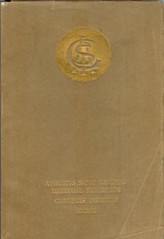 I have Augustus Saint Gaudens bookmarked on eBay and the above mentioned catalogue was entered for sale and I won it! I thought your readers might be interested in a personnel book review of a 1909 Memorial Exhibition catalogue held at the Carnegie Institute.
I have Augustus Saint Gaudens bookmarked on eBay and the above mentioned catalogue was entered for sale and I won it! I thought your readers might be interested in a personnel book review of a 1909 Memorial Exhibition catalogue held at the Carnegie Institute.
Augustus Saint Gaudens Memorial Exhibition, Carnegie Institute, MCMIX that's the cover to this one hundred year old catalogue. The cover itself is in remarkable condition considering its age. That's not to say it doesn't have a few creases and rips. You open to the first couple of pages and you know right away this catalogue is very unusual, the pages are roughly sewn, not the smooth surfaces we are used to seeing in today's finely tuned printed specimens. Once again technology has advanced somewhat in a hundred years.
The memorial exhibition was held at the Carnegie Institute, Pittsburgh, PA. from April 29th to June 13th, 1909. The Fine Arts Department under its Director John W. Beatty, M.A. sponsored the event. Some of the Trustees of the Carnegie in 1909 included some very powerful and influential Western Pennsylvanians (and maybe why this exhibition took place in Pittsburgh): John A. Brashear, George H. Clapp, Andrew W. Mellon and W. Lucien Scaife just to name a few.
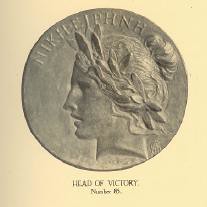 A Few Words of Appreciation by John W. Beatty covers pages four through eleven where he expresses his praise of the sculptor's work, "In the Sherman monument, there is expressed the glory of the triumphant conqueror; in the Shaw Memorial, the courage and devotion of the patriot; and in the Lincoln, the patience, and solicitude or love of the great President." He concludes his five page Appreciation with the following thought "He possessed the power to portray an exalted thought in truthful terms, as have few men in the history of art."
A Few Words of Appreciation by John W. Beatty covers pages four through eleven where he expresses his praise of the sculptor's work, "In the Sherman monument, there is expressed the glory of the triumphant conqueror; in the Shaw Memorial, the courage and devotion of the patriot; and in the Lincoln, the patience, and solicitude or love of the great President." He concludes his five page Appreciation with the following thought "He possessed the power to portray an exalted thought in truthful terms, as have few men in the history of art."
Pages 13 through 26 gives a history of Saint Gaudens and is signed H. ASPET.(Could this mean his son, Homer wrote this biography while at ASPET, their family estate at Cornish, New Hampshire?)
 Page 27 lists Honors and Degrees awarded to Augustus Saint Gaudens among them are some of the following: Corresponding Member, Institute of France; Officer of the Legion of Honor, 1901; Member, Royal Academy of the Sciences and Letters of the Beaux Arts, Belgium; Member, American Academy in Rome, 1905; Member, Royal Academy, London; Medal of Honor, Paris, 1900; Special Medal of Honor, Buffalo, 1901; Grand Prize, St. Louis, 1904; A Founder of the Society of American Artists; Member of the National Academy of Design and a number of honorary degrees from Harvard, Princeton and Yale Universities.
Page 27 lists Honors and Degrees awarded to Augustus Saint Gaudens among them are some of the following: Corresponding Member, Institute of France; Officer of the Legion of Honor, 1901; Member, Royal Academy of the Sciences and Letters of the Beaux Arts, Belgium; Member, American Academy in Rome, 1905; Member, Royal Academy, London; Medal of Honor, Paris, 1900; Special Medal of Honor, Buffalo, 1901; Grand Prize, St. Louis, 1904; A Founder of the Society of American Artists; Member of the National Academy of Design and a number of honorary degrees from Harvard, Princeton and Yale Universities.
Pages 29 through 92 lists all of the 132 works of Saint Gaudens donated(lent) by a who' who in American culture at the turn of the century. Mrs. Augustus Saint Gaudens lent a few items from the Cornish Studios among them were: a low relief bronze medal of John S. Sargent, signed and dated Paris, 1880: a low relief of Homer Saint Gaudens dated New York, 1882; a plaster cast from bronze high relief of Amor Caritas; Diana, a bronze cast from a study for the head, without date.
Other contributors included: Daniel Chester French, Louis Saint Gaudens, C. F. McKim, Mrs. Glover Cleveland, Kenyon Cox, Misses Hettie E. Anderson, Mrs. John Hay, Metropolitan Museum of Art, Harvard University, ANS, The United States Mint, the United States Military Academy at West Point, Henry Hering and the list goes on.
The catalogue describes each item with at least a paragraph of vital information and the dozen or so black and white photo plates add to the overall effectiveness of this rare one hundred year old memorial.
CORRECTIONS AND SUGGESTIONS
Joe Ciccone of the American Numismatic SOCIETY writes:
Thanks for including my email. One minor correction: I work for the ANS not the ANA (American Numismatic Association). I only mention this because when I return to the office I'll have a manager or two asking me whether I've switched my affiliation. :)
Oops! Sorry for the typo - I shouldn't work on these issues at midnight on my sister-in-law's dining room table, but sometimes that's the only timeslot available...
Secretary-Treasurer David Sundman's report on the Numismatic Bibliomania Society General Meeting included this note:
Karl Moulton
The year 2009 is proving to be a bumper year for libraries coming out for auction. Dave Bowers has sent Karl 340 cartons from his research library. He has scheduled three sales for next year. These auctions contain much that David Bowers has used to put his wonderful books together.
Tom Wetter writes:
I am aware that David Sklow will be holding three auctions of Bowers research material next year and was wondering if Karl will be holding three additional sales, or if that was just a typo.
It was indeed a typo as both Dave Sklow and Karl Moulton were quick to point out (although knowing Dave Bowers, I wouldn't have been surprised to learn of another large book consignment. Anyway, Bowers' 340 cartons of books were consigned to David Sklow and will appear in several of his upcoming numismatic literature sales.
David Sundman writes:
In editing the NBS report for The E-Sylum, numismatic literature dealer David Sklow’s remarks regarding David Bowers’ library consignment were misattributed by the secretary-treasurer to the preceding speaker. The amended correction follows:
David Sklow reports the year 2009 is proving to be a bumper year for libraries coming out for auction. Dave Bowers has sent Sklow 340 cartons from his research library for auction. Sklow has scheduled three sales for next year, Part I-February 2010; Part II-June 2010 and Part III-October 2010.
These auctions contain much that David Bowers has used to put his wonderful books together over the years, to include: Limited Edition works; Pirates, Treasure hunting, American Maritime history, the California Gold rush 1848-1850's; an extensive and comprehensive libraries on Civil War history; runs and individual copies of historical reference materials, encyclopedias, collected papers and more. There are numerous numismatic works, limited editions, periodicals, journals and papers included as well.
See David Sklow’s website for more details: http://www.finenumismaticbooks.com/
Joe Boling asks:
David Sundman writes:
Joe is just another example of the sharp-eyed readers of The E-Sylum. Sorry for my mistakes on these prices realized. The total amount realized was correct. Here are the corrections to the prices realized in the NBS auction:
- Lot #3. The John Weston Adams Collection of Medallic Distinctions Awarded to North American First Peoples, Stack’s catalog, January 13-14, 2009. Sold for $600. [not the $300 previously reported]
- Lot #4 Whitman Encyclopedia of Colonial and American Coins, by Q. David Bowers, signed the author and all in attendance at the NBS Symposium held August 6, 2009. Sold for $7,500.10 [not the $7,500.00 previously reported]
So where did the ten cents come from? I asked auctioneer Brad Karoleff, who writes:
I had a bid and wanted an increase from $7,500 to 10K. The high bidder responded "$7,500, not a dime more", at which time I sold it to him for $7500.10 just to make a point.
That's what we love about having Brad as our annual auctioneer - he squeezes the last dime out of his marks, er, "bidders", and still leaves them (and the audience) entertained.
To read the earlier E-Sylum article, see: REPORT ON THE NBS GENERAL MEMBERSHIP MEETING (http://www.coinbooks.org/esylum_v12n33a03.html)
From the suggestion box - Bob Rhue writes:
I have always found the index at the beginning of each issue – an important item I might add – to be the most difficult to read. I believe that the ease of readability would increase tenfold by simply leaving a blank line in between each separate index item. Would you be willing to give that a try?
Thanks for a great job of disseminating a huge diversity of interesting numismatic information!
Well, formatting changes aren't always so easy, but I was able to tweak the vertical space between list items a bit. Hopefully this has helped to improve readability without making the table of contents too long. Thanks for the suggestion!
THE BOOK BAZARRE
SWOGER SUES OVER NUMISMATIC RESEARCH USE
The Brasher Doubloon is steeped in historic reverence and mystique. It dates to Colonial America and the dawning of the new federal government, when Spanish gold doubloons circulated alongside other foreign gold and silver as part of New World commerce.
Seven of them remain and are sanctified as the first truly American gold coins. That fact, along with their distinctively American design and Brasher's friendship with Washington, attached a permanent legacy to the coins.
The coins are nearly identical, but one of them is first among equals. And it is that coin, worth $15 when Washington was president but most recently sold for nearly $3 million, that is at the heart of a lawsuit filed in Orange County Superior Court. Rare coin researcher William Swoger says he told the coin's owners that he had "specialized information" about the coin and that they reneged on finalizing a contract to pay him in exchange for the information.
Orange County coin dealer Steven Contursi and his Northern California partner, Donald Kagin, teamed up to buy the Brasher Doubloon in 2005 for $2.99 million, then the second-highest price ever paid for an American coin. Swoger's lawsuit alleges that he approached Kagin and Contursi several months ago and told them the coin was worth much more than they realized.
The key, he told them, is that the coin wasn't the first of the seven struck by Brasher beginning in 1787. Contrary to the prevailing view in numismatic circles, Swoger says it was the last, and probably not struck until 1793.
That later date is crucial, Swoger says, because this coin was fractionally heavier than the others and made to conform to a 1793 act of Congress that established weight standards for gold coins in the new republic. The other six coins are of identical weight and predate the formation of the new government, he says.
Kagin and Contursi "knew they had a unique coin," says Richard Herman, a Newport Beach attorney who is representing Swoger. "They knew it was very valuable, very rare. But they thought it was the first one [in the series] and not the last one. Turns out that makes all the difference in the world. One's a Colonial coin made by a jeweler, and it's a very nice coin, but the other is the first coin made for circulation under a law of the United States. That's heavy-duty."
According to the lawsuit, Swoger informed the owners that he had discovered information that would make their coin much more valuable and asked for a $500,000 fee. They countered with $250,000, the suit alleges, and then asked for a meeting at which Swoger would disclose the information.
Swoger met with Kagin, explained his thesis and was given a gold coin valued at $35,000 as a down payment, the suit alleges. Swoger alleges Kagin said he and Contursi would prepare a contract but never did. Swoger is suing for millions of dollars in damages.
On the advice of their attorney, Contursi and Kagin declined to discuss the matter. But Contursi, the president of Rare Coin Wholesalers in Dana Point and a two-thirds owner of the coin, wrote in an e-mail:
"I greatly regret that Mr. Swoger has chosen to sue me and my partner. We never sought anything from Mr. Swoger regarding the Brasher Doubloon and never benefited in any way from any information he volunteered to us. The lawsuit is utterly frivolous, and I urge him to withdraw it."
Armen Vartian, an attorney representing the coin's owners, said, "I don't think the complaint will survive a motion to dismiss."
In an interview, Swoger, who is 65 and lives in Lake Odessa, Mich., said he is confident he can prove the coin was the last in the series and not the first. He declined to provide details.
Asked if he'd been nervous about disclosing his information to Kagin without a contract, Swoger said, "Yes, I was, but how can they buy a pig in a poke? So, it was a necessary step."
Kagin subsequently said they weren't going to use his information and felt no need for further payment, Swoger said. "Whether they use it or not, I delivered it," he said. "They know it and now other people are going to know it. They can't give it back to me."
The lawsuit alleges that Swoger's theory would elevate the coin's value to $10 million.
The lawsuit is an uncommon event in the world of rare-coin collecting, but there's no doubt that the Brasher Doubloon is fertile territory for intrigue.
"There's still quite a bit that's unknown about these coins," said Beth Deisher, editor of Coin World magazine, in a phone interview from her office in Sidney, Ohio.
Coin World will report on the lawsuit this week, but Deisher declined to express an opinion on it. Swoger has written for her magazine and is respected for his research in the coin-collecting world, she said. He has not published any documentation for his theory about the Brasher Doubloon.
And if Swoger's theory is correct?
"It would elevate the coin's historical importance," Deisher said. "Whether that translates to value is something that would have to be determined by the marketplace."
To read the complete article, see:
Colonial-era coin at the center of lawsuit
(www.latimes.com/news/local/la-me-doubloon-lawsuit18
-2009aug18,0,5355676.story)
So... just how much IS numismatic research worth? And how does one quantify it? Numismatics is full of stories of stolen or plagiarized research, but I'm not aware of any monetary settlements in past disputes.
Numismatics is also home to at least a few authors who value their work so highly that they price it out of reach of their market. In an E-Sylum review of Swoger's recent book on the National Commemorative Medals of the U.S., Dick Johnson said the book "is overpriced at a whopping $225." I'm curious to learn what E-Sylum readers think. -Editor
ANSWER: 1851 DATED ONE DOLLAR ITEM IS A FANTASY PIECE
Last week Jim Duncan asked,
I have been shown a coin - silver dollar size, and looks to be silver. It has on obverse an Indian head (as 1 cent) with UNITED STATES OF AMERICA around in serif face, and * * under neck.
The reverse is also UNITED STATES OF AMERICA around in very plain sans serif, a wreath within and within the wreath 1 / DOLLAR / 1851 (also very sans serif). No initials or mint marks of any sort.
I think it's a fantasy, but the owner has hopes. Can anyone in the USA provide more information please?
Tom DeLorey writes:
This is a fantasy piece made in China to sell to tourists. I have seen several of them brought back by unsuspecting travelers. They are also sold in the Chinatown sections of several major U.S. cities.
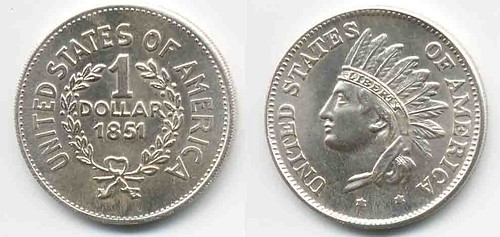
Gar Travis found the above image on the web. Jim and Tom confirmed that we're all discussing the same piece. Many thanks to everyone for their quick response - we had an answer to this query before most readers were done with their Monday morning coffee. -Editor
Alan Weinberg also agrees that it's "absolutely modern". He adds
There are ironically an abundance of 1851 dated brass and G-S $1 "gold" spielmarks. Always 1851...guess that was the common date gold dollar the Germans had access to.
The Germans (often Lauer) struck brass, iron and German silver copies of numerous U.S. coins as "play money" rather than intending them to be passable counterfeits. There is an old Token and Medal Society supplement, I believe by long-deceased author Howard Kurth, which lists and pictures many of these spielmarks.
QUERY: FRENCH FIVE FRANCS OF NAPOLEON
Granvyl Hulse writes:
Is there anyone in our E-Sylum group that is knowledgeable about French five francs of Napoleon? Many years ago I acquired a 5 Franc AN12 KA660.2 with the B mint mark of the Rouen mint. Only 10,000 were struck. The coin has original mint luster and from all I can gather it had been in a private collection from the very first.
I have only seen one for sale in all the years I have had it and I presumed that the bulk of the coins were struck to pay a debt and were melted down by the country they were sent to and re-issued as their currency. I am trying to obtain an approximate value for insurance purposes and I just don't trust the prices in the Krause catalog. Do you know anyone I could ask?
QUERY: RECORDS OF MINNEAPOLIS MEDAL MAKER WENDELL'S SOUGHT
Sheldon Banoff writes:
I'm in the process of cataloguing town anniversary medals, tokens, badges and fobs issued by all US towns (for their centennials, sesquicentennials, etc.). Wendell's (formerly Wendell-Northwestern), Minneapolis, was by far the largest medalist during the 1950's-1970's (or longer).
Does anyone know if their records pertaining to medals and tokens they struck were preserved anywhere? I'm looking for all details, e.g., mintages, descriptions of the obverse and reverse, diameters, types of metal(s) struck, issue prices, pictures, you name it. BTW, I called the company several years ago and they told me they do not retain records and none were available for research, etc.
VOCABULARY QUIZ QUESTION: BICENQUINQUAGENARY
Walking recently down the main street of Warrenton, VA (a beautiful little town), I came across a storefront advertising a "bicenquinquagenary" celebration. How many years does that mouthful of a word represent? In numismatics we often encounter medals commemorating the centennial or bicentennial of an event (100 and 200 years, respectively). Are there any medals for a bicenquinquagenary celebration?
JOE LASSER ON DUTCH LION DOLLARS IN COLONIAL AMERICA
Two weeks ago, we published a quote from a newspaper article about a Lion Dollar found in a Pennsylvania field. Last week, Ray Williams questioned the story's facts on where the coin was minted. Here's the relevant quote:
Hallman's most worthy find — a 1643 Lion dollar made in Mexico for the Dutch. It was found in the same field where he discovered the hoe blade.
"It is the oldest silver coin in Pennsylvania, New Jersey, Maryland and Delaware," he said. "The coin tells me when the first white influence was in this area. I recently donated it to the Mennonite Historians."
Joe Lasser writes:
I find it difficult to believe that counterfeit Lions were struck in Mexico during our colonial period. There was no specific incentive to create false coins in Mexico and it's not logical to think that someone could positively identify where a counterfeit was minted.
Mr. Hallman apparently has his story backwards. It is possible (and probable) that the Dutch Lion Dollar he found was made with Mexican silver. From about 1550 to 1750 65-70% of all the new silver that came into the world was from Spanish colonial Mexican and Peruvian (today's Bolivia) mines. As the arguably largest commercial sailing nation -- that did not have any silver mines -- it is completely logical and normal that Lion Dollars could -- and did -- reach Pennsylvania.
After all, the Dutch controlled the Colony of New York until the 1660's and some of the first paper money of New York in 1709 stated its value in Lion Dollars. Yes, there are "imitation" Lion Dollars minted in several other European countries -- primarily Italy and Germany -- although there is one from Transylvania -- that clearly illustrate the trade currency role of Lion Dollars. It was a "Bullion World" and Mr. Hallman's find is another small confirming episode.
To read the earlier E-Sylum articles, see:
1643 LION DOLLAR UNEARTHED IN PENNSYLVANIA FIELD
(www.coinbooks.org/esylum_v12n32a16.html)
QUERY: DID THE SPANISH REALLY MINT LION DOLLARS IN MEXICO?
(www.coinbooks.org/esylum_v12n33a11.html)
QUERY: HOW LATE WERE SHILLINGS AND PENCE USED IN THE U.S.?
Philip Mernick of London writes:
I am currently reading "The Potters & Potteries of Bennington" by John Spargo (1926 reprinted Dover, New York, 1972) and in quoting diary entries from the 1820s giving prices of pots, some items are priced in dollars and cents and others in shillings and pence. Could people still be using shillings in Vermont at that time?
Since I was already corresponding with him, I forwarded Philip's question to longtime colonial money collector Joe Lasser, who writes:
The answer is quite clearly "yes" looked at from several viewpoints. First, keep in mind that our fledgling mint had produced and was producing only a very limited amount of coinage. Dr. Dick Doty points out in America's Money America's Story that only 50 cent pieces were struck in 1810, 1812, 1813 and 1817 and that seven of the ten authorized denominations ... "were unpopular and rarely struck because there existed better-known foreign coins that were preferred in trade" .
Secondly, it is generally accepted that English coinage denominations historically had been the customary presentation in money of account for decades. Also, remember that Canada is Vermont's neighbor to the north and that Montreal is closely proximate to Vermont's border. As a consequence, English coinage easily could have circulated in the nearby area.
All of these factors plus the fact that U.S. coinage did not become the sole legal tender in our country until 1857 indicate that it would be a normal and customary practice to express prices in both American and English terms.
Philip Mernick adds:
It seems clear from the diary entries quoted that currency played relatively little part in the rural economy at that time and in that place. Most business was done by exchange with whatever other commodity was available, often cider.
THE BOOK BAZARRE
QUERY: GUTTAG'S RARE COINS OF THE UNITED STATES
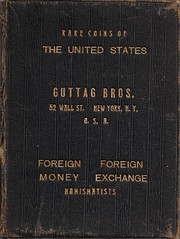 I have a question regarding what appears to be a numbered edition of a Guttag publication: Guttag Bros., 1921 edition of Rare Coins of the United States / Foreign Money / Foreign Exchange / Numismatics. 16 mo ( 6 x 4 1/2 inches), 112 + I - IV(index) pp, hard-bound, gold edging all around.
I have a question regarding what appears to be a numbered edition of a Guttag publication: Guttag Bros., 1921 edition of Rare Coins of the United States / Foreign Money / Foreign Exchange / Numismatics. 16 mo ( 6 x 4 1/2 inches), 112 + I - IV(index) pp, hard-bound, gold edging all around.
Question: this copy is numbered "15." Are other copies also numbered? Any sense of the size of this edition? While the copy I just purchased is well worn, it appears that the Guttag Bros. were offering a fine, possibly limited edition. A scan of a fine copy would be welcomed. Any information would be appreciated.
Many thanks to the readership for past responses to my inquiries regarding the Guttag Bros.
QUERY: ENGRAVED MORGAN SILVER DOLLAR INFORMATION SOUGHT
Ginger Rapsus writes:
I am seeking information on engraved Morgan dollars, especially the 1921-D. I managed to track down most of the engraved pieces. I note that one was offered at an auction in June and did not sell. I also recall seeing an 1878-S, Specimen, engraved in the field. It could have been an Eliasberg coin. Thanks.
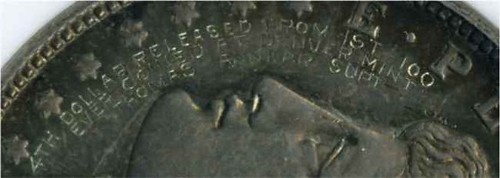
From www.brokencc.com/dollarerrors.php:
The June auction Ginger mentions was by Bowers and Merena. Lot 3322 was an engraved 1921-D Morgan silver dollar similar to the one pictured above, but numbered #12. The lot description references a pamphlet which I've never seen, an interesting acquisition for a bibliophile.
Naturally, the entire story of the first 100 1921-D dollars is covered in Dave Bowers' Silver Dollar Encyclopedia (pages 2686-2688), although the pamphlet is not mentioned. Can anyone supply an image of it? -Editor
This lot includes a large bound pamphlet entitled 12TH DOLLAR RELEASED FROM 1ST 100 EVER COINED AT DENVER MINT. THOMAS ANNEAR SUPT. [1921]. The front cover of the pamphlet also states:
Contained between these covers are copies of the auction catalogue descriptions, antiquarian documents and published articles over the year concerning this unusual rare coin and its eleven sister coins and of the historical event that caused their existence.
DICK JOHNSON SAYS: PLEASE DO NOT SLAB ART MEDALS
A question arose this week of "slabbing" art medals. No need to. The intent of coins is to circulate as money and they are slabbed to prohibit unwanted tarnish and to prevent any further wear or damage.
But the intent of art medals is entirely different; they do not circulate and they are given a protective finish to prohibit any tarnish. Medal makers often highlight or give a patina finish to art medals that are almost always lacquered. That is protection enough to be handled by humans to embrace the feel of their relief forever. The intent of art medals is to be able to hold, to touch, to feel that relief. Along, of course, with the beauty and significance of their design.
Medals are usually larger, most often over two inches, so art medals would not fit the standard size slab for coins and tokens. Coins are slabbed, it seems, to be able to handle and store these numismatic items but also to facilitate their sale by the stated variety and condition. As such they can change ownership a dozen times a year.
That is not the case for medals. The buyer of a medal typically wants to own it for a long time, to appreciated its tactile thrill in addition to its beauty and design.
Very infrequently medals have been embedded in Lucite, and perhaps this could be considered an ersatz slab. But the most convincing argument I can give is this: I have been asked more often how to remove a medal from a plastic embedment, than how or where to have it embeded in the first place.
READER THOUGHTS ON ANA CONVENTION SITE SELECTION
Ginger Rapsus writes:
Last year, I stayed at the headquarters hotel, the Renaissance. When I reached my hotel, I roamed around outside in 95-degree heat, looking for the convention center. After nearly 30 minutes, I gave up and took a cab. I took cabs back and forth to the show. I did not see anyone else from the show at the hotel when I had breakfast. The Hyatt was only a short skywalk away from the convention center.
The Denver "HQ" hotel was a 3-block walk from the convention center, and not the most pleasant walk, while another hotel was across the street from the convention center. My point is...why isn't the "HQ" hotel the one closest to the convention center?
In regards to Alan Weinberg's comments regarding the recently completed ANA convention in Los Angeles we would like to make these comments. Alan did mention that venues for ANA conventions have to be better. And yes, we agree that attendance could have been better at this show but it wasn’t terrible. Here are our comments.
In regards to the location of downtown Los Angeles - we would rather see the ANA go to Anaheim when making a selection in California. One reason for having shows in California is that about 10% of the ANA membership resides in that State. California also has the most ANA member Coin Clubs. We would also like to see ANA conventions in the summer go to sites like Baltimore (every three or four years); Chicago (every three or four years); Anaheim (every three or four years - depending on the tax situation and relief from the nexus like this year in Los Angeles) and a Boston or Philadelphia thrown into the mix at times.
Alan mentioned the hotels. When ANA picks a site we wish they would they would pick only sites that don’t need a shuttle. This convention needed one. At least in the case of Los Angeles, the shuttle ran quite frequently between the three convention hotels. The Holiday Inn was a host hotel and located just a few blocks from the convention center. This hotel was adequate and we stayed there for the entire run of the show. The other host hotels were the Wilshire and Sheraton. Both were fine according to friends who stayed there. Other then the Holiday Inn, no other name hotels were close to the convention center. Pre-convention room rates for the three mentioned hotels weren't cheap but not ridiculous. Two new hotels are being built near the convention center, but won't be ready for a year or so.
Alan mentioned the parking fees. We think the $12 parking fee is very reasonable for a downtown parking lot. Some folks mentioned to us that within a quarter mile they found $8 parking. We stayed at a Hilton on Monday the week of the show and that was about a mile away. It was the nearest Hilton chain brand near the convention center. We walked there and back taking different routes. We found very few street people, unlike San Francisco and even Portland. At these two events the street people were aggressive in asking for money, etc.
Many fine restaurants were in the area of the convention center. The Liberty Grill (behind the Holiday Inn) was the site of the TAMS banquet. The food and service were great, and attendance was on par with past TAMS banquets. The PNG banquet on Tuesday night was also attended by about the same number of dealers as in the past. Likewise with the food at this event which was great.
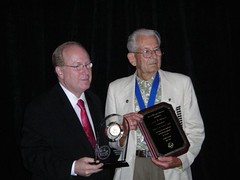 The ANA banquet at the Wilshire also had good food with an attendance approaching 300. At the banquet, the new ANA board was installed (see photo), and among the many awards and membership accomplishments, John Eshbach received the ANA Farran Zerbe Award (see photo). Incidentally, to help balance the ANA budget, everyone who used to get a free banquet ticket (staff, volunteers, committee members, judges, exhibitors, Board members, and past Presidents), now have to pay $25 towards the price of the banquet ticket. We have no problem with this as the ANA in the past two years worked hard to balance the budget and had to take steps that had to be hard for them - such as this.
The ANA banquet at the Wilshire also had good food with an attendance approaching 300. At the banquet, the new ANA board was installed (see photo), and among the many awards and membership accomplishments, John Eshbach received the ANA Farran Zerbe Award (see photo). Incidentally, to help balance the ANA budget, everyone who used to get a free banquet ticket (staff, volunteers, committee members, judges, exhibitors, Board members, and past Presidents), now have to pay $25 towards the price of the banquet ticket. We have no problem with this as the ANA in the past two years worked hard to balance the budget and had to take steps that had to be hard for them - such as this.
At the opening ceremonies, Numismatist Dwight Manley donated $250,000 to the ANA, for use in the Florence Schook School of Numismatics. Thank you, Dwight, for this outstanding donation to the ANA. In 2002, Mr. Manley donated this same amount to the ongoing ANA building fund. Besides these amounts this numismatic icon donates countless other money to the ANA (and others) for other numismatic projects.
We wouldn't call it the worst ANA we have ever attended but somewhere in the middle. We have been attending ANA conventions since 1979. As for the convention center itself, it was very user friendly, and we had no problems with it. The bourse itself was well lit and with the wide aisles it did appear at first glance that not many people were in attendance. At times we walked through the bourse and many of the dealers had customers at their tables. Yes, the tax problem in CA did cause some people (dealers and collectors) not to come to the show. It is costly to attend an ANA convention and no one likes tax problems included in the equation, thus they didn’t come.
The local committee was located just up the escalator from the entrance, and they did a great job of directing visitors to the pay and membership booths. As ANA longtime National Volunteers, we had a good vantage point to see who was attending the convention. We were located down the hallway from where folks paid admission and or were given credentials to enter the convention bourse area.
Sitting behind our lectern, we talked to hundreds of people who attended regarding many different things. We were ANA greeters who gave directions and information to those who needed it. We wondered about charging admission to ANA conventions when we first heard about it. At this convention, the ANA had reduced the cost for an online membership to $18 from the usual $28 for an online membership. Many were convinced to pay the $18 online membership in lieu of the $6 daily admission. Paying the dues made sense if they attended more then one day as the multiple pay for entrance was $6 daily, or $20 for the Wed. through Sun. of the show. Sunday we think was free (or for a short time a reduced $2 admission was charged). All they had to do was register.
Not many complained to us, the volunteers at the booth collecting admissions or the ANA staff regarding the cost of admission to attend the convention. At our position near the entrance, we were able to convince over twenty to take their $6 badge and convert it for $12 more to an ANA online membership. As for ANA recruitment, we think that this was the highest amount of new members ever signed up at an ANA convention.
At the Holiday Inn one morning a dealer did tell us that he and several other dealers didn't like the $6 admission charge. Out of many hundreds of dealers who had booths, this dealer was the only one who complained, at least to us.
We'd also like to mention the official program for this event. It was changed from the handy pocket edition to a program the size of The Numismatist. Everyone called it the 13th edition of the monthly magazine. It had great information for new collectors. Somehow ANA has to have a pull out insert with the pertinent information for the show.
As most dealers, collectors and exhibitors would agree, the ANA is the largest coin show in the world. We always hope it is in a great city. Alan mentioned cities for ANA conventions. The site selections are picked for the ANA by the Board of Governors, with suggestions by the ANA Convention Staff and Executive Director.
Our kudos's to recently installed President Cliff Mishler, Vice President Tom Hallenbeck and Board Members Joseph Boling, Jeff Garrett, Chet Krause, J. P. Martin, Walter Ostromecki, Scott Rottinghaus and Wendell Wolka. If you enjoyed or hated this convention and or have opinions one way or another on how to make the show better go to www.money.org and under contacts you will find the email addresses for the Board, Exec. Dir. and Convention Department. Make your feelings heard and let them know your thoughts good or bad.
Besides the Bourse the ANA two conventions offer so much more in the area of educational talks, exhibits, world mints & bureaus, other activities including a luncheon, base ball game - plus other activities for attendee's, coin club tables and others. The ANA also features a major auction, this year held by Bowers and Merena.
You need the entire week of the show plus many more days to see and do everything an ANA convention offers. Whether we were volunteers or just interested in coin collecting we would attend an ANA convention wherever it is held. We also exhibit and judge at ANA conventions and enjoy the camaraderie and friendships we have in this area of the hobby. In any instance, we agree with some of Alan's comments but wanted to let you know our thoughts and what we think are the other parts of an ANA convention.
BRAD KAROLEFF ON THE LOS ANGELES ANA CONVENTION
Much has been said about the recent ANA convention in LA, most of it negative. I do agree that it was possibly the worst I've ever had from a business standpoint. The location IS NOT totally to blame. The market had more to do with the lack of business than where the convention was held. Let's face it, if the market was booming dealers would go to the mouth of a volcano for a bourse. The public would follow hoping to not be left out of an exciting time or good deal.
Conversely, in a cold market it is difficult to get many people to stop sitting on their hands protecting their diminishing cash position while still attempting to get out of their stale inventory at a profit. I priced a number of coins there for not only my stock but for my personal collection. Twice I was willing to pay substantially over "bid" for common eye appealing coins to be quoted double that price. Another time I priced a coin for a client to be told "my cost is $1100, I'll take $1150." After passing the cost came down to $1100. I had passed on similar coins on the floor for $800. This type of pricing in a down market does not stimulate sales. We will have to wait for some of these dealers to run out of cash and be forced into lower selling prices.
As far as the admission charge for the show, it is LONG OVERDUE! I suggested to the ANA many years ago that they should be charging NONMEMBERS for admission. I routinely pay $6 or more to attend local gun, antique, jewelry, rock and mineral shows in my area. The are only LOCAL shows, not a NATIONAL show of the importance of the ANA. After all, membership should have its' privileges. If someone does not want to fork over a measly sum like $6 (or $20 for a complete show pass) they aren't that interested in what's on the floor. They can join the organization and become more educated about the hobby and attend for free. Why should they have a free ride? This was NOT the reason for the sparse attendance.
The hotel location(s) were not ideal, but workable. I was multiple blocks from the convention center and walked there most mornings. No trouble. I felt secure and saw nothing that would alarm this Midwestern hillbilly.
The show did have all the educational opportunities available at any ANA convention. The lack of business just allowed more time to visit with old (an new) friends and attend more club meetings. Was the glass half empty or half full?
The ANA had record numbers of boy and girl scouts attend their merit badge seminars. GOOD NEWS! How many of those scouts will eventually be collectors and members of the organization? The Young Numismatist events for the ANA were slightly off from previous years, which mirrors the general attendance at the show. I did see many enthusiastic youngsters there looking to participate in the treasure hunt and other activities. One I met was interested in error coins and we spent a few minutes together. I would like to thank Fred Weinberg for taking some time to help him. I would bet that he will become a long term collector.
The NBS meeting was a very enjoyable part of my convention this year as always. The auction was incredible. The participants put up with a lot and were VERY generous to the society. I would like to personally thank John Adams, Secretary Sundman and President Hamelberg for their good nature and generosity in this year's auction. Without members like them the society would be a kindler, gentler oops!... I mean it would be lacking the expertise and generosity not seen in many other groups. Thanks guys!
I can only hope that those of you reading these reviews who did not attend will find the opportunity to come to a future convention and experience the package for yourself. I can't imagine going without the annual ANA convention.
THE BOOK BAZARRE
MYSTERIOUS LEDGER SIX NINE FOUR: MONEY TO BURN
An old hundred page ledger was lent me by a friend who is a seeker after treasure hoards. Bound in coarse green burlap boards, a tiny office label written on the cover in fountain pen reads "694" and nothing more. Patented in 1882, Ledger 694 was filled with various columns of inked sums peeking through by the bound edge.
Recycled about the year 1900, each page was then scrapbooked with newspaper columns tipped in over the calculations. All are neatly composed, some sideways, to fill each legal size page. Columns are set off with corner flourishes as someone familiar with typesetting or layout skills might render. No newspaper banner is included, so I cannot give credit to the original publisher, but the stories seem centered about New York and Boston and depict events circa 1900 to 1902. None have turned up on the Internet using various old newspaper searches although some of the stories are classics, reprinted later such as an early clipping recalling the inscription in Abraham Lincoln’s pocket watch, which we know came true.
This is a time capsule of "fresh, forgotten" material not easy to find on the Web. My friend said the ledger came from a large collection of clippings mainly concerning gruesome "true crime," suitable for the penny-dreadful, but the theme of this ledger is about people unexpectedly coming into money, finding treasure and discovering rare coins, historic relics or pursuing curious and exotic hobbies. In resonance with Ripley’s Believe-It-Or-Not, Ledger 694 may have been a New England newspaperman’s reference file of stories of particular human interest from the turn of the twentieth century. The first clipping with illustration sets the "gold standard" and reads:
Sends Shaw an Order for Bonds, Greenbacks and Postal Currency for Kindling Washington D.C. October 22nd – The following letter was received at the treasury department yesterday morning:
"New York City, Oct. 3. The Honorable the Secretary of the Treasury, Washington D.C.
Sir – Prices for the customary kinds of winter fuel having reached an altitude that puts them out of reach of literary persons in straitened circumstances, I desire to place with you the following order: Forty-five tons best old dry government bonds, suitable for furnace, gold 7 per cents, 1864, preferred. Twelve tons early greenbacks, range size, suitable for cooking. Eight barrels seasoned 25 and 50 cent postal currency, vintage of 1866, eligible for kindlings. Please deliver with all convenient [dispatch]."
Mark Twain is smugly pictured beneath. His sentiments were shared by many "goldbugs" of that day who believed the only honest dollar was a gold dollar.
ARTICLE FEATURES NUMISMATIC AUTHOR FRED HOLABIRD
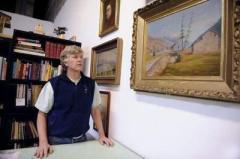 As a California college student in the 1970s, Fred Holabird would run in the mountains near Eureka, Calif., and see people digging up bottles from the 1800s.
As a California college student in the 1970s, Fred Holabird would run in the mountains near Eureka, Calif., and see people digging up bottles from the 1800s.
"I thought it was the most ridiculous thing I had ever head of," Holabird said. "And they were worth money, which was even more ridiculous." But it was one of the things that put Holabird on a path for a career selling antiques and Americana, in conjunction with a career in mining.
His interest in history also led to the discovery of some of the most important Gold Rush-era documents found in the last generation, such as letters from brothers Hosea and Ethan Allen Grosh were acquired last year by the Nevada Historical Society.
Former Nevada State Archivist Guy Rocha is a Holabird fan. "He's not only had an impact on Nevada, but also on the region and maybe on the nation, with some of his salvage work," Rocha said. "I don't know of anybody like him in this state in the private sector who has done more to further Nevada's heritage. ... "What I would say first and foremost about Fred is how he has cared about Nevada and has not put profit before this."
Interest in history and collecting runs deep in the Holabird family. His great-grandfather collected books with railroad magnate Henry Huntington, who founded the Huntington Library in 1919. His family also has a tradition of studying history. But he also liked rocks. That led to him studying geology at Humboldt State University, earning his bachelor's degree in 1976.
In following his mining passion, he ended up managing two open pit gold mines, the Gold Bar at Beatty and Flowery at Virginia City. When the mining business was ebbing, he focused more on the collecting side. He wrote books including "The Nevada Bottle Book," which put stories about the bottles with pictures. Holabird said he figured people wanted more than just listings. There's also "Pioneer Minor Coinage of American Saloons," a guide to collecting saloon tokens. And in 1983, he started a business involving historical American items.
Rocha has noted Holabird's efforts on the Grosh letters and other projects. "What strikes me about Fred in this world of dealership and antiquities and documents, he has a stellar reputation," Rocha said. "I'm always somewhat jaundiced about some of these people who are dealers because some of them are less than credible. But Fred, in making a livelihood in this business, he has always thought about what is best for Nevada.
To read the complete article, see: (http://m.rgj.com/news.jsp?key=205159)
NEWTON AND THE COUNTERFEITER AUTHOR ON MODERN COUNTERFEITING
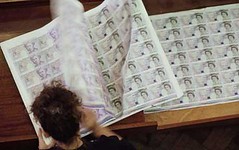
On the morning of March 22, 1699 a prisoner in Newgate was brought to the hanging tree at Tyburn, now Marble Arch. He played to the crowd, praying loudly and then placing his own hood over his head before the executioner’s men pulled the ladder out from under him. He dangled, twitching and choking for minutes – the trapdoor gallows would not come into routine use in Britain for another 50 years – until at last he drooped.
Thus died William Chaloner, the most notorious counterfeiter of his day, brought to his death by the Warden of the Royal Mint – a former Cambridge don named Isaac Newton.
Chaloner’s case marks a key turning point in the history of counterfeiting – one in which money fakery was moving from coining, to the forging of the brand-new forms of paper money just entering circulation in the 1690s. Chaloner took advantage of the shift with astonishing speed. In June 1695, when the first Bank of England notes, starting at £5, were issued, the Bank’s governors believed that the use of marbled paper – rare then, and very expensive – would be sufficient to deter forgers.
They were wrong. The rewards were large enough to make it worth Chaloner’s while to put money up front for the costly materials and craftmanship necessary. By August 1695, his false notes were in circulation.
Chaloner’s defeat of the Bank’s first anti-counterfeiting measure marked the first shot of what would become a technological arms race between governments and forgers. For the first century, the advantage lay with fakers – and nowhere more spectacularly than in Britain’s North American outposts.
The Massachusetts Bay Colony had first issued paper money in 1690. The other gold-and-silver poor territories of British America followed suit. Most colonial notes were poorly printed and anti-counterfeiting measures were generally notional, no more sophisticated than the motto on a New Jersey 30 shilling note that read "To counterfeit this bill is DEATH." And with each colony issuing its own paper, counterfeiters in New York, for example, could produce fake Virginia notes – and if they passed at a discount as "foreign" exchange, who cared?
In response, America’s founding scientist, Benjamin Franklin invented a better bank note. Collaborating with nature-artist Joseph Breintnall, Franklin published a collection of metal cuts produced from plaster casts of leaves. Starting in the late 1730s, he and other colonial printers used the leaf designs to create what were, in essence, early security markers on the paper to be used for printing money.
With the coming of the digital revolution, high-quality scanners and colour printers became employed. Standard mistakes include using regular, cellulose-based paper instead of rag and failing to touch up scans before printing. Stupidity pops up, too, as in the 2005 case of counterfeiters in Arizona who sent their printer in for repair – with a sheet of fakes still jamming the works.
Careful workers do much better, of course. Bleaching and reusing the paper from small denomination bills gets around one major issue. Photo retouching software can improve colour reproduction enormously. Crumpling and wearing false bills can reduce the "feel" difference between false and legitimate money. Digital counterfeiting has become the technique of choice: as late as 1995, less than one per cent of the counterfeit money seized by the US Secret Service was produced on inkjet printers; by 2008, it was 60 per cent.
Which leads to the last twist to the story. There is one corner of contemporary counterfeiting in which Chaloner would feel right at home. The last real security innovation added to British coins came in 1662, with the advent of designs milled into the edges of coins. Now, using methods largely unchanged since Chaloner’s day, modern coiners are producing £1 pieces in bulk at a cost of roughly half the face value of the coins. That’s enough of a margin to make the enterprise worthwhile – to the point that as reported by the BBC in September 2008, the Royal Mint estimates that as many as one in 50 circulating £1 coins is a dud.
As Ecclesiastes says: there is nothing new under the sun – certainly not in the pursuit of easy money.
To read the complete article, see: In the pursuit of easy money (www.telegraph.co.uk/science/6044714/In-the-pursuit-of-easy-money.html)
HOWARD BERLIN VISITS THE MUSEUM OF THE NATIONAL BANK OF BELGIUM
I’m currently in Belgium drinking some of the several hundred kinds of beer, sampling some of the liqueur-filled chocolate truffles, and eating a few Belgian fries. I also managed to pay a visit to the Museum of the National Bank of Belgium, which just a few blocks from my hotel. Its collection is heavy on bank notes (25,000) and it has about 6,000 coins, 2,000 tokens, and 2,000 medals.
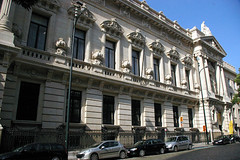
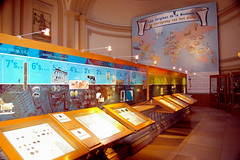
Much of the 15 display rooms focus on its role as the central bank but the largest room (#4) is devoted to the historical display of money from ancient times to the present, including primitive money, and Belgian coins and bank notes from 1830. I have attached two photos of the museum – one outside and one inside of a partial view of room #4. Everything is in French and Dutch with very, very brief English.
I also wanted to thank all those who responded to my query in the E-sylum several months ago about my "numismatourist" travel book idea with their encouragement and suggestions. Because I had been away and had other writing deadlines, I havn't had a chance to properly respond to each of them but will do so in the next few weeks. Upcoming scheduled trips to visit museums between November and next March include London/Birmingham, Tokyo (with a sumo match - me watching, not participating and me learning how to make sushi), Warsaw, and Berlin.
ROBOTS MAKING COINS AT THE ROYAL AUSTRALIAN MINT
If you visit the Royal Australian Mint you will see a very busy, large, orange Kuka Titan robot, tipping coin blanks for delivery to the presses, tipping finished coins for packing into boxes and impressing visitors.
Dale Rogers, project manager for the Materials Handling and Warehousing Project (MHWP) at the Mint, said that until this year the materials and warehousing functions were carried out in a very manual fashion with very little technology.
The star of the new system is definitely the Kuka Titan robot, visible to visitors from the foyer. But it also works with new Automated Guided Vehicles (AGVs), a bucket elevator system, surge hoppers and a vision counting system; all of which are underpinned and managed by an MES (Manufacturing Execution System).
The robot is the same as that used by Isuzu to build trucks, so it is well-used to hard work.
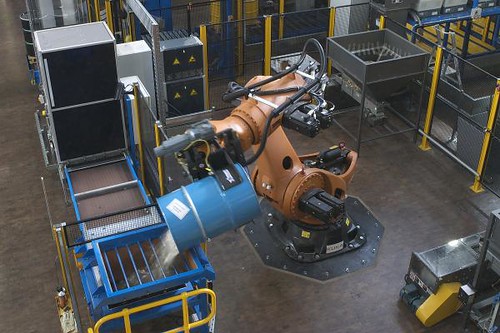
The new automated MHWP system is end-to-end. It starts and finishes at the basement dock. Staff in the dock unload blank coins onto a conveyor, the starting point of the materials handling system.
From there, the pallet of blanks in drums are barcode scanned and metadata is attached to each drum. An AGV then takes the drum from the basement and puts it in to storage. At the same time, the MES is monitoring production on the ground floor. Every evening, a night schedule runs which ensures that all of the finished goods from that day are taken to the new vault and new blanks are brought from storage in the basement, up the lift to the coin hold.
When the press runs out of blanks, the system automatically calls up the MES. The Kuka Titan robot takes delivery and decants the blanks in to the new vision counting system.
The vision counting system is a CCTV camera connected to a computer, which counts the blanks on the conveyor belt. The camera can count 15,000 blanks per minute and the blanks are then placed in the bucket elevator and delivered to the designated press.
"People have had to change their work habits because the system is thoroughly integrated from end-to-end, but at the same time we've tried to design it to be as friendly to the existing processes as possible," he said.
Overall, the project has been very successful in meeting the objectives: reducing occupational health and safety (OH&S) issues, increasing security and increasing productivity.
"We are finding that the AGVs are much safer and more reliable. Robots are never affected by having a bad night with the baby and falling asleep at the wheel. They are extremely accurate and they always do the same task in the same way."
To read the complete article, see:
Robots make the coins go round downunder
(www.computerworld.com.au/article/315600/
robots_make_coins_go_round_downunder)
TOKENS SPREAD MESSAGE ABOUT DOMESTIC ABUSE
Coin tokens with the message "Don't live with domestic abuse" will be handed to Berkshire residents to raise awareness about the issue.
The tokens, which are the same size as a £1 coin, can be used for shopping trolleys and gym lockers, Slough Borough Council said.
The contact number for the charity Women's Aid is included on the coins.
Slough Domestic Abuse Forum members will hand the tokens out at Montem Leisure Centre on Wednesday.
A council spokesman said: "Each month, Slough's domestic abuse unit deal with more than 300 reports of domestic abuse, ranging from verbal arguments to more serious assaults and violent attacks."
Sophie Wing-King, domestic abuse co-ordinator for Berkshire East, said: "We know many people will experience domestic abuse but will not report it to the police or local support agencies.
"We want to encourage anyone living in an abusive relationship to seek help, whether they are the victim or the perpetrator.
"These £1-sized tokens are another way of getting the message out that domestic abuse is unacceptable and there is help available."
To read the complete article, see: 'Domestic abuse tokens' given out (news.bbc.co.uk/2/hi/uk_news/england/berkshire/8208154.stm)
UKRAINIAN ARRESTED FOR SMUGGLING AN ANCIENT COIN FROM RUSSIA
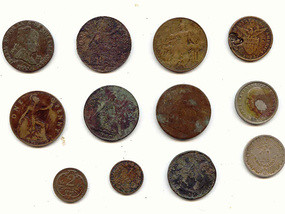 Customs officers have detained a Ukrainian citizen who was trying to smuggle a unique ancient coin, thought to date to the fourth century BC, from Russia into Ukraine.
Customs officers have detained a Ukrainian citizen who was trying to smuggle a unique ancient coin, thought to date to the fourth century BC, from Russia into Ukraine.
The press service of the Crimean customs service reported on Wednesday that a copper coin had been found in his wallet at the Kerch customs post.
According to preliminary reports, this is a coin from Panticapaeum dates to around 314-310 BC.
"Our compatriot had no certificate for the cross-border transfer of such an item, and the coin was not declared orally or in a written form. The [person] said that he had found this coin long ago, that he was not familiar with the rules for the cross-border transfer of such items, and that he had not consulted with customs officers," the press service said.
To read the complete article, see: Ukrainian detained for attempting to smuggle ancient coin into Ukraine (http://www.kyivpost.com/nation/46950)
Hmmmm. The illustration with the article had me puzzled, and I wasn't the only one. In his August 17th blog post, Ed Snible writes:
To read Ed's complete blog post, see: Ukrainian detained for attempting to smuggle ancient coin into Ukraine (digitalhn.blogspot.com/2009/08/ukrainian-detained-for-attempting-to.html)
'HYPNOTIC' BANK ROBBERS ARRESTED
'A FAMILY of bank robbers', who allegedly hypnotise cashiers into giving them money, have been arrested, police said yesterday.
The couple, along with their infant son, operated as a family and are accused of robbing banks and finance company cashiers in Manama for the last few months.
Their latest robbery was reported by a bank cashier on Sunday, who claimed to have been "hypnotised" into parting with BD900 when given a $100 banknote to exchange.
They first told police they are Iranians then said they are from Turkey and later said they are from Syria.
"They reportedly approach cashiers and claim they are visitors who want to exchange currency," said the source.
"They reportedly get the cashier under the influence of hypnosis who then parts with more money than he or she is supposed to give."
To read the complete article, see: 'Hypnotic' bank robbers arrested (www.gulf-daily-news.com/NewsDetails.aspx?storyid=257907)
A Utah bank robber helpfully wrote his demands on a piece of paper that listed his personal details on the other side.
The man reportedly walked into a bank and handed a note demanding cash which he received.
But it turned out the other side of the note listed information the man had provided for a drug screening including his name, social security number and birth date.
Police used the information to look up the man's driver's license and compared the license photo to security video before arresting the man.
To read the complete article, see:
Bank robber hands over personal information
(www.bartlesvillelive.com/content/weirdnews
/Bank-robber-hands-over-personal-information/OxNg-k2RVkqr61SOF4XgbQ.cspx)
FEATURED WEB VIDEO: THE FUTURE OF PAPER
This week's Featured Web video is The Future of Paper, recommended by David Klinger. The episode discusses the future of paper, including implications for paper money and of course, bibliophiles.
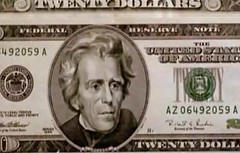
Is paper on the way out? Mo Rocca looks to the future of paper for the inaugural episode of "The Tomorrow Show."
www.cbsnews.com/video/watch/?id=5243310n

